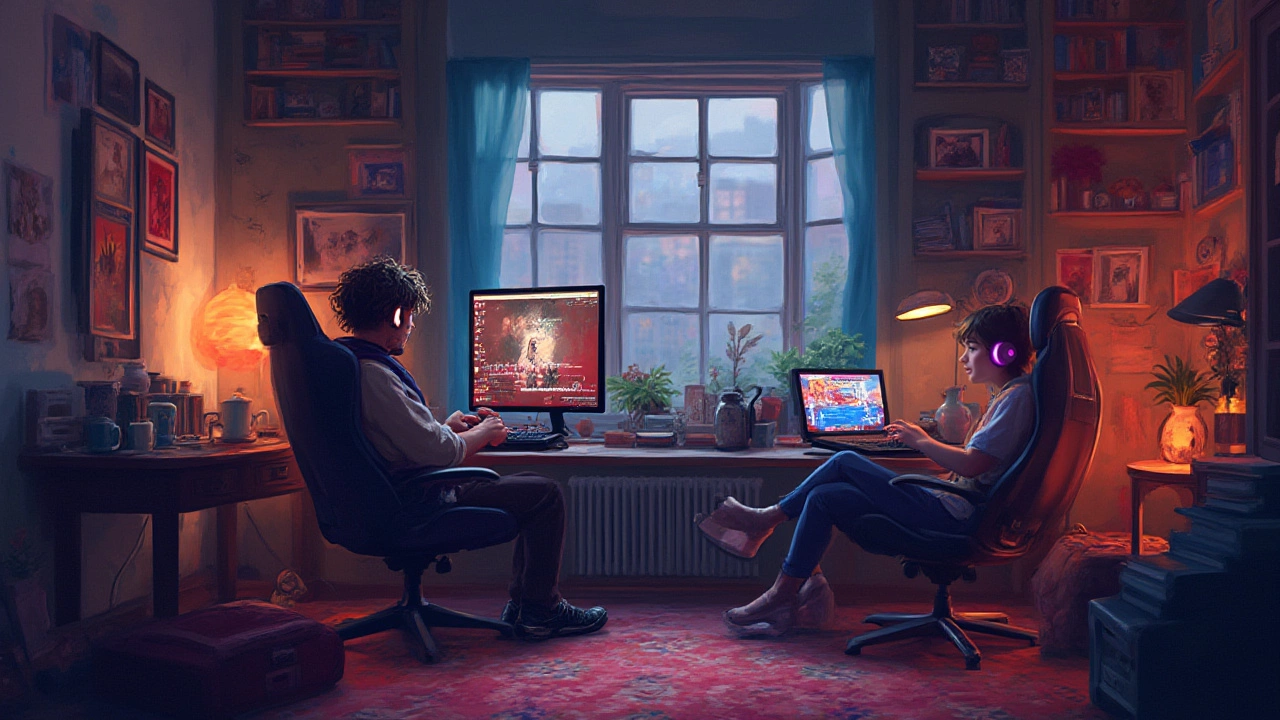You probably hear it all the time—someone online claims you “need” 32GB of RAM for a fast PC, while your buddy insists 16GB runs everything just fine. It can feel like a tech version of ‘my dad is stronger than yours.’ Thing is, the right answer isn’t as simple as picking the biggest number. It’s all about matching your RAM to how you actually use your computer—instead of just flexing for forum points. Think about it: how many browser tabs do you keep open? Are you a video editor or just here for YouTube and spreadsheets? Memory isn’t an upgrade you notice every day, until suddenly you do—like when your game stutters, or your laptop freezes during a Zoom call with 24 Chrome tabs (it happens). The real challenge is not getting sucked into marketing hype. Let’s get into the realities of 16GB vs. 32GB RAM, using real scenarios, facts, and a heavy dose of common sense.
What RAM Really Does—And Why It’s Not All About the Specs
RAM (Random Access Memory) is short-term memory for your computer. Every image, tab, app, and game you load lives in RAM while you’re using it. When your PC runs out of RAM, it has to use much slower hard drive space to juggle things. That’s when you get stutter, lag, or the dreaded spinning circle of death. But here’s the thing: throwing more RAM at your PC doesn’t always mean it goes faster. If you’re not using more than 8GB, adding extra is like buying a king-sized mattress for a dorm room—nice, but pointless.
Modern Windows (and macOS) chew up more RAM than you might expect in 2025. Just starting Windows 11 and a few apps, you can hit 4-6GB easily. Popular browsers like Chrome, Edge, or Firefox are notorious for gobbling up RAM; open 15-20 tabs and you’re suddenly over 8GB, especially with lots of images, streaming video, or Google Docs humming in the background. Still, for office work and general browsing, 16GB remains the sweet spot—even after all the updates and bloatware.
Why do gamers keep talking about RAM? Most modern games recommend 16GB as a baseline for smooth play, but only a handful of new “AAA” games this year actually push near 12-14GB during gameplay. Open-world titles (think Cyberpunk 2077 on the highest settings, or Microsoft Flight Simulator) will reward you with a bit more breathing room at 32GB, especially if you refuse to close Discord, Spotify, and browsers while playing. But if you shut everything else down during gaming sessions, you’re rarely in danger with 16GB.
What about creative work? This is where things get interesting. If you’re editing 4K video, handling massive Photoshop projects, or creating music with dozens of tracks and plugins, then 32GB (or even more) isn’t overkill at all. Apps like Adobe Premiere, Photoshop, and After Effects can eat every gigabyte you give them, especially if you like to multitask. Blender, CAD, DaVinci Resolve—these love RAM. Check your usage in Task Manager next time you’re working; if you’re regularly maxed out, that’s your sign.
Most laptop buyers just hoping for a machine to last five years? Here’s the hitch: lots of thin-and-light laptops have RAM soldered in. Buy 8GB now, and you can’t upgrade later. For future-proofing, 16GB makes sense, but only heavy power users or creative types need to future-proof to 32GB. This brings us to another reality—more RAM doesn’t always solve slowdowns. A weak CPU, a slow SSD, or a hundred background apps can make you think “I need more memory,” when the real problem is elsewhere.
Let’s get concrete. Memory prices in 2025 have bounced around with chip shortages, but 32GB kits cost about twice what 16GB kits do, though some sales put them closer. For desktops, upgrading later is usually painless—just drop in more sticks. For laptops, check for an extra RAM slot and avoid soldered designs if you’re not sure about your future needs.
Quick fact for the skeptics: There’s a sweet spot for RAM speed too, not just size. Most real-world tests show barely any boost when moving from 3200MHz to 5600MHz for basic usage or gaming. But workstation apps with huge data sets or integrated GPUs can benefit. For most folks, size matters more than speed.

Scenarios: Who Actually Needs 32GB, and Who’s Fine With 16GB?
Let’s run through the main categories. Gamers come first. If all you do is fire up games like Elden Ring, Fortnite, Valorant, or even new single-player releases—and you’re okay with closing other apps—16GB is perfect. It’s the goldilocks zone: your games run smooth, and your PC doesn’t turn into a space heater. Few titles (like Star Citizen in its current, buggy glory) will push beyond 16GB, but those are outliers. Games don’t need as much RAM as the latest online posts claim. CUDA, DLSS, DirectStorage—these are mostly GPU features and SSD speeds, not RAM-dependent stuff.
Multitaskers—or folks working or studying on machines that never get rebooted—are different. If you’re the kinda person who keeps Slack, 30 Chrome tabs, Word, Spotify, Steam, and a couple of messaging apps running, 16GB can fill up faster than you’d think. Windows is getting more memory-hungry with every update. For peace of mind, 32GB means never having to close anything. Web developers, designers, or people who need lots of virtual desktops (especially on macOS) will also feel the comfort. If you spend your day in heavy web tools (Figma, Canva, Notion) and regularly have 3-4 big apps running, you’ll notice the difference when you jump to 32GB—apps stay open in the background, launching is quicker, and things just feel more “instant.”
Let’s look at content creators and professionals. Here’s where 32GB can actually save you time—and time is money, right? If you’re editing high-res video (4K or bigger), working in huge Photoshop or Lightroom files, running 3D rendering jobs, or doing anything that chews up gigabytes at a time, you’ll waste less time waiting for caches to clear or scratch disks to hit. Add in a few browser tabs and reference sheets, and 16GB gets eaten fast. The story for music producers, coders spinning up a dozen virtual machines, or people running data science work is the same. If RAM gets even close to full, it starts dumping data to your SSD, and even the fastest NVMe drive is almost snail-speed next to RAM. One recent Puget Systems benchmark (they build PCs for creators) found Photoshop, Premiere, and After Effects had big jumps in speed when moving from 16GB to 32GB—sometimes over 25% depending on project size.
Regular users—the folks who check email, scroll Instagram, watch Netflix, and use some Office docs? 16GB is absolute luxury. Apps launch in a blink, updates run without hiccups, and you can stream 4K video with Slack and Spotify running. Spend the difference on a bigger SSD or splurge for a quieter laptop fan.
One more thing: future-proofing is all about your upgrade path. If you can pop in more RAM later, it’s fine to start with 16GB (unless you already feel cramped). For non-upgradable laptops, be honest: will you change how you use your machine a year or two from now? If you’re just joining college, remote working, or might get into creative work, future-proofing with 32GB makes sense. Remember, RAM is not a magic bullet for every PC slow-down, but running out of RAM is a quick way to break your workflow.

Smart Tips and Common Mistakes: How to Decide What You Need
Here’s the good news: you don’t have to guess. You can actually see how much RAM you’re using. On Windows, hit Ctrl+Shift+Esc and check the Performance tab in Task Manager. Mac users, launch Activity Monitor. Check while doing your heaviest workload—gaming with Discord in the background, 20 tabs open while streaming, or running your biggest project in Adobe apps. If the usage is regularly above 90%, or you see a lot of “swap” drive activity, you need more RAM. Easy as that.
Now, let’s talk about mistakes people make. First, do not blindly buy the biggest RAM kit just because you read a scary Reddit post or a fancy YouTuber’s sponsored build. That’s how you end up spending $150 you really could have used for a better monitor or a comfy chair. RAM that sits unused doesn’t make your PC “smoother”—it just sits there, like an empty seat at the dinner table. The exception: some memory-hungry tasks actually pre-load project files into RAM for speed, so check specific recommendations for your app.
Next, don’t obsess over RAM speed unless you know you’re running workloads that care about bandwidth (blender simulations, huge spreadsheets with complex macros). Modern CPUs make more use of RAM speed than CPUs from even 4 years ago, but unless you’re shooting for benchmarks, the real gains come from adding more GB. Just buy decent, brand-name RAM that matches your machine’s required spec (usually DDR4 or DDR5, whichever your motherboard supports—don’t mix!) and check if your mainboard supports dual-channel config for best results.
Watch out for another trap: mixing and matching RAM from different brands or sizes sometimes reduces stability, so try to buy kits in pairs or as a matched set for desktops. For laptops, check if adding RAM voids your warranty (still an issue on some models). Also, 32-bit versions of Windows can’t use more than 4GB RAM—this is only relevant on fossil hardware, but worth mentioning so you don’t spend money for no reason.
Thinking about the future? A few facts: Chrome and Edge keep getting optimized, but web apps are eating more memory as they get more powerful. Windows 12 is on the horizon and will definitely bump up its requirements—even now, Windows 11 recommends at least 8GB for smooth running, and many new laptops won’t let you upgrade after purchase. AAA games will trend upward, but past experience shows the 16GB standard should hold strong for a couple more years unless you’re on the cutting edge. For pros, time is money—if you can save even 15-20 seconds per task, 32GB pays for itself over time.
- If your main goal is worry-free browsing, streaming, office work, and entry-level photo edits? Stick with 16GB, and don’t look back.
- If your workflow involves creative suites, virtual machines, constant multitasking, or you love having “all the things” open? Jump to 32GB and enjoy the silence as your laptop doesn’t scream in protest.
- If you’re buying for a desktop you may upgrade later, save now and upgrade only when you feel the crunch.
- For non-upgradable laptops, 16GB is safe for most people, but 32GB gives peace of mind if you plan to keep the machine for ages or your job gets heavier. It’s very tough to predict future requirements, but web bloat isn’t slowing down.
- Gamers: if your rig is new, your GPU and CPU matter far more than RAM (past 16GB), except in special cases or if you’re streaming live while playing.
Let’s cut the drama. For most people in 2025, 16GB RAM is that perfect sweet spot between waste and worry. You only need 32GB if your apps are already begging for it, you run a creative studio out of your home, or you never let yourself close anything. Next time you’re tempted by a 32GB up-sell at checkout, check your Task Manager first—that extra memory might be better spent elsewhere. Save your cash or put it into a blazing fast SSD or a higher-refresh monitor; you’ll notice the difference way more than a chunk of unused RAM.

